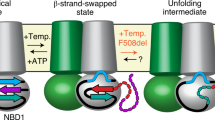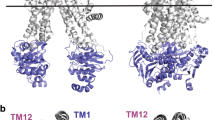Abstract
Cystic fibrosis can be treated by potentiators, drugs that interact directly with the cystic fibrosis transmembrane conductance regulator (CFTR) Cl− channel to increase its open probability. These substances likely target key conformational changes occurring during channel opening and closing, however, the molecular bases of these conformational changes, and their susceptibility to manipulation are poorly understood. We have used patch clamp recording to identify changes in the three-dimensional organization of the extracellularly accessible parts of the CFTR protein during channel opening and closing. State-dependent formation of both disulfide bonds and Cd2+ bridges occurred for pairs of cysteine side-chains introduced into the extreme extracellular ends of transmembrane helices (TMs) 1, 6, and 12. Between each of these three TMs, we found that both disulfide bonds and metal bridges formed preferentially or exclusively in the closed state and that these inter-TM cross-links stabilized the closed state. These results indicate that the extracellular ends of these TMs are close together when the channel is closed and that they separate from each other when the channel opens. These findings identify for the first time key conformational changes in the extracellular parts of the CFTR protein that can potentially be manipulated to control channel activity.







Similar content being viewed by others
Abbreviations
- ABC:
-
ATP-binding cassette
- CF:
-
Cystic fibrosis
- CFTR:
-
CF transmembrane conductance regulator
- CHO:
-
Chinese hamster ovary
- cryo-EM:
-
Cryo-electron microscopy
- CuPhe:
-
Copper(II)-o-phenanthroline
- DTT:
-
Dithiothreitol
- ECL:
-
Extracellular loop
- NBD:
-
Nucleotide-binding domain
- TM:
-
Transmembrane helix
References
Bosch B, De Boeck K (2016) Searching for a cure for cystic fibrosis. A 25-year quest in a nutshell. Eur J Pediatr 175:1–8
Zegarra-Moran O, Galieta LJV (2017) CFTR pharmacology. Cell Mol Life Sci 74:117–128
Linsdell P (2017) Structural changes fundamental to gating of the cystic fibrosis transmembrane conductance regulator anion channel pore. Adv Exp Med Biol 925:13–32
Callebaut I, Hoffmann B, Mornon J-P (2017) The implications of CFTR structural studies for cystic fibrosis drug development. Curr Opin Pharmacol 34:112–118
Chin S, Hung M, Bear CE (2017) Current insights into the role of PKA phosphorylation in CFTR channel activity and the pharmacological rescue of cystic fibrosis disease-causing mutants. Cell Mol Life Sci 74:57–66
Moran O (2017) The gating of the CFTR channel. Cell Mol Life Sci 74:85–92
Sorum B, Czégé D, Csanády L (2015) Timing of CFTR pore opening and structure of its transition state. Cell 163:724–733
Gao X, Hwang T-C (2015) Localizing a gate in CFTR. Proc Natl Acad Sci USA 112:2461–2466
Wei S, Roessler BC, Icyuz M, Chauvet S, Tao B, Hartman JL, Kirk KL (2016) Long-range coupling between the extracellular gates and the intracellular ATP binding domains of multidrug resistance protein pumps and cystic fibrosis transmembrane conductance regulator channels. FASEB J 30:1247–1262
Liu F, Zhang Z, Csanády L, Gadsby DC, Chen J (2017) Molecular structure of the human CFTR ion channel. Cell 169:85–95
Zhang Z, Liu F, Chen J (2017) Conformational changes of CFTR upon phosphorylation and ATP binding. Cell 170:483–491
Tordai H, Leveles I, Hegedüs T (2017) Molecular dynamics of the cryo-EM CFTR structure. Biochem Biophys Res Commun 491:986–993
El Hiani Y, Linsdell P (2014) Metal bridges illuminate transmembrane domain movements during gating of the cystic fibrosis transmembrane conductance regulator chloride channel. J Biol Chem 289:28149–28159
Linsdell P (2017) Architecture and functional properties of the CFTR channel pore. Cell Mol Life Sci 74:67–83
Zhang Z-R, Song B, McCarty NA (2005) State-dependent chemical reactivity of an engineered cysteine reveals conformational changes in the outer vestibule of the cystic fibrosis transmembrane conductance regulator. J Biol Chem 280:41997–42003
Beck EJ, Yang Y, Yaemsiri S, Raghuram V (2008) Conformational changes in a pore-lining helix coupled to cystic fibrosis transmembrane conductance regulator channel gating. J Biol Chem 283:4957–4966
Wang W, Linsdell P (2012) Alternating access to the transmembrane domain of the ATP-binding cassette protein cystic fibrosis transmembrane conductance regulator (ABCC7). J Biol Chem 287:10156–10165
Wang W, Linsdell P (2012) Relative movements of transmembrane regions at the outer mouth of the cystic fibrosis transmembrane conductance regulator channel pore during channel gating. J Biol Chem 287:32136–32146
Zhou J-J, Li M-S, Qi J, Linsdell P (2010) Regulation of conductance by the number of fixed positive charges in the intracellular vestibule of the CFTR chloride channel pore. J Gen Physiol 135:229–245
Mense M, Vergani P, White DM, Altberg G, Nairn AC, Gadsby DC (2006) In vivo phosphorylation of CFTR promotes formation of a nucleotide-binding domain heterodimer. EMBO J 25:4728–4739
Li M-S, Demsey AFA, Qi J, Linsdell P (2009) Cysteine-independent inhibition of the CFTR chloride channel by the cysteine-reactive reagent sodium (2-sulphonatoethyl) methanethiosulphonate. Br J Pharmacol 157:1065–1071
Zhou J-J, Fatehi M, Linsdell P (2008) Identification of positive charges situated at the outer mouth of the CFTR chloride channel pore. Pflügers Arch 457:351–360
Fatehi M, Linsdell P (2009) Novel residues lining the CFTR chloride channel pore identified by functional modification of introduced cysteines. J Membr Biol 228:151–164
Gao X, Bai Y, Hwang T-C (2013) Cysteine scanning of CFTR’s first transmembrane segment reveals its plausible roles in gating and permeation. Biophys J 104:786–797
Vergani P, Nairn AC, Gadsby DC (2003) On the mechanism of MgATP-dependent gating of CFTR Cl− channels. J Gen Physiol 121:17–36
Broadbent SD, Wang W, Linsdell P (2014) Interaction between two extracellular loops influences the activity of the cystic fibrosis transmembrane conductance regulator chloride channel. Biochem Cell Biol 92:390–396
Negoda A, El Hiani Y, Cowley EA, Linsdell P (2017) Contribution of a leucine residue in the first transmembrane segment to the selectivity filter region in the CFTR chloride channel. Biochim Biophys Acta 1859:1049–1058
Linsdell P (2015) Metal bridges to probe membrane ion channel structure and function. Biomol Concepts 6:191–203
Holmgren M, Shin KS, Yellen G (1998) The activation gate of a voltage-gated K+ channel can be trapped in the open state by an inter-subunit metal bridge. Neuron 21:617–621
Heymann G, Dai J, Li M, Silberberg SD, Zhou H-X, Swartz KJ (2013) Inter- and intrasubunit interactions between transmembrane helices in the open state of P2X receptor channels. Proc Natl Acad Sci USA 110:E4045–E4054
Zhou Y, Xia X-M, Lingle CJ (2015) Cadmium-cysteine coordination in the BK inner pore region and its structural and functional implications. Proc Natl Acad Sci USA 112:5237–5242
Corradi V, Vergani P, Tieleman DP (2015) Cystic fibrosis transmembrane conductance regulator (CFTR): closed and open state channel models. J Biol Chem 290:22891–22906
Bai Y, Li M, Hwang T-C (2010) Dual roles of the sixth transmembrane segment of the CFTR chloride channel in gating and permeation. J Gen Physiol 136:293–309
Bai Y, Li M, Hwang T-C (2011) Structural basis for the channel function of a degraded ABC transporter, CFTR (ABCC7). J Gen Physiol 138:495–507
Wang W, El Hiani Y, Linsdell P (2011) Alignment of transmembrane regions in the cystic fibrosis transmembrane conductance regulator chloride channel pore. J Gen Physiol 138:165–178
Gao X, Hwang T-C (2016) Spatial positioning of CFTR’s pore-lining residues affirms an asymmetrical contribution of transmembrane segments to the anion permeation pathway. J Gen Physiol 147:407–422
Acknowledgements
We would like to thank Christina Irving for technical assistance. This work was supported by Cystic Fibrosis Canada.
Author information
Authors and Affiliations
Corresponding author
Rights and permissions
About this article
Cite this article
Negoda, A., Cowley, E.A., El Hiani, Y. et al. Conformational change of the extracellular parts of the CFTR protein during channel gating. Cell. Mol. Life Sci. 75, 3027–3038 (2018). https://doi.org/10.1007/s00018-018-2777-0
Received:
Revised:
Accepted:
Published:
Issue Date:
DOI: https://doi.org/10.1007/s00018-018-2777-0




